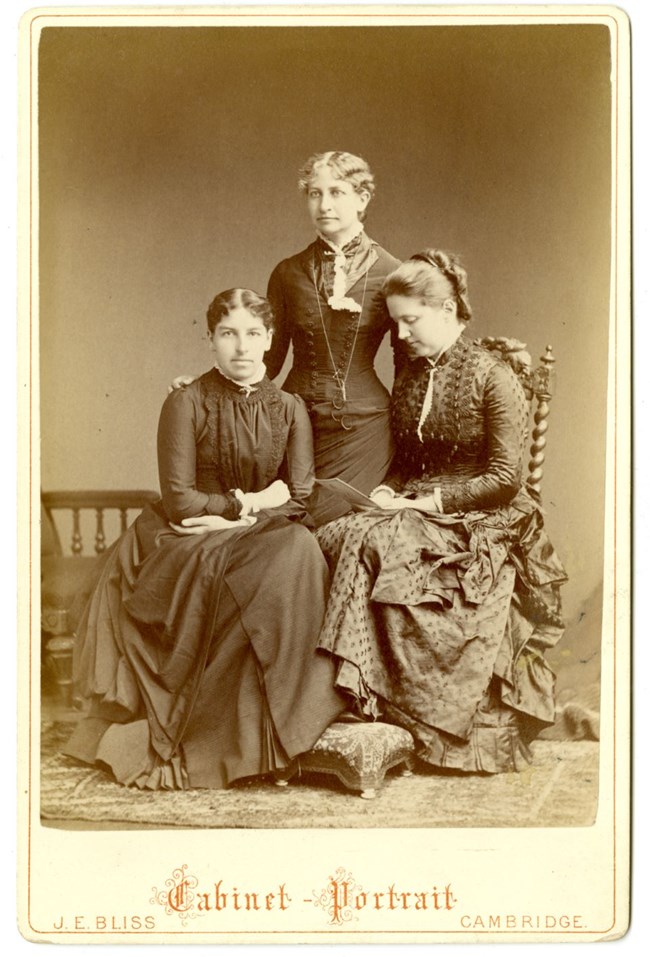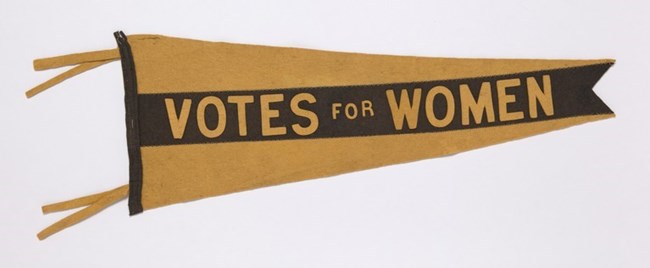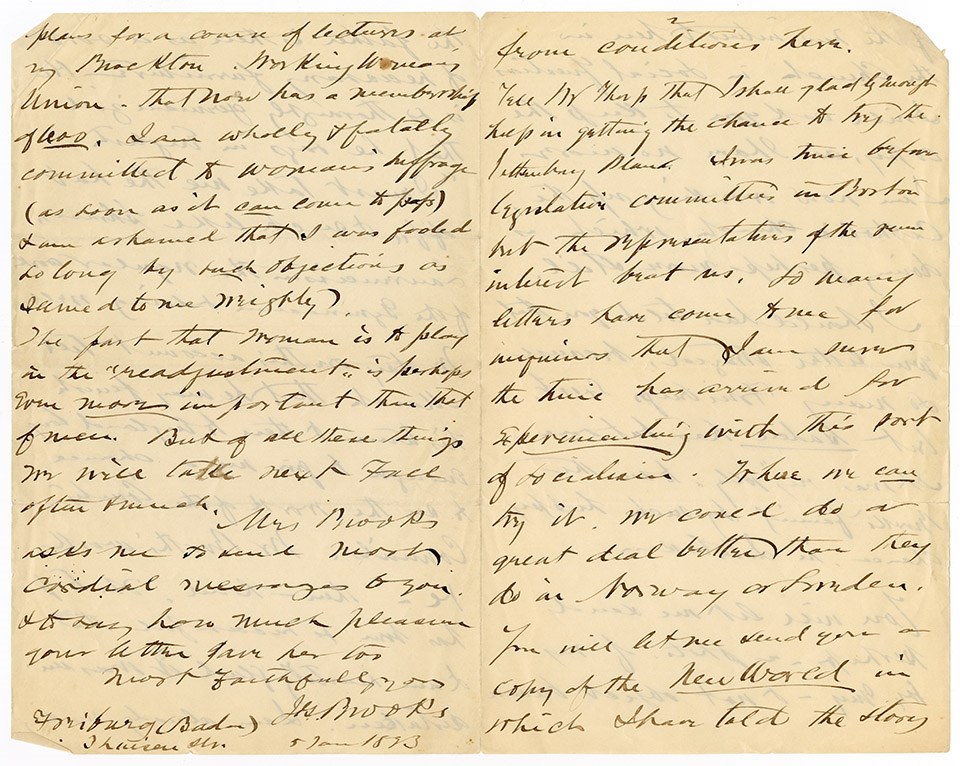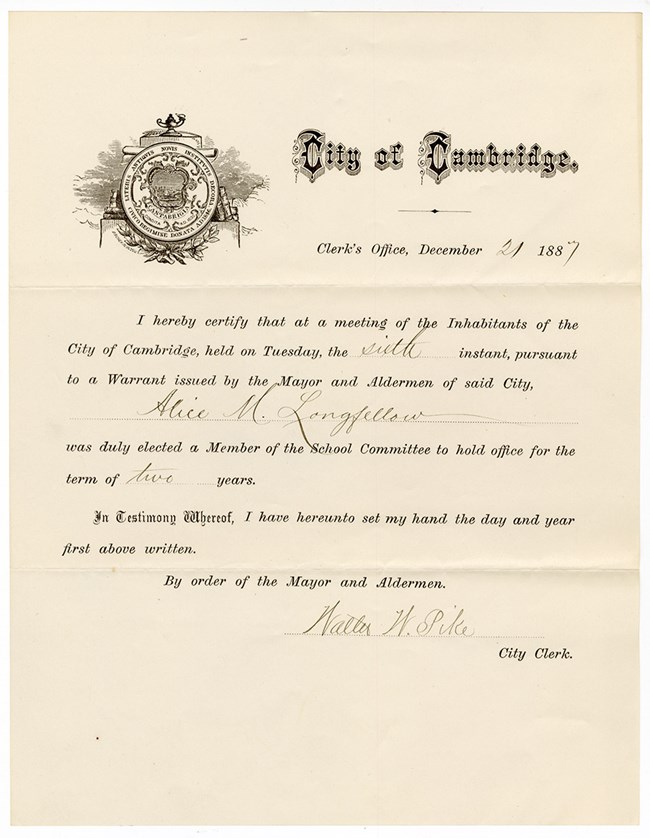Last updated: March 7, 2023
Article
Alice Longfellow: A Silent Suffragist

Longfellow Family Photograph Collection. Longfellow House - Washington's Headquarters NHS. (3007.002/002.004-#024)
Alice Longfellow was the daughter of the famous poet Henry Wadsworth Longfellow and the well-known Boston socialite, Fanny Appleton Longfellow. Intelligent and outspoken, Alice grew up to be known in her own right for her advocacy of women’s education. She was particularly central to the founding of Harvard’s female arm, Radcliffe College. Yet Alice was far less outspoken on suffrage.
Suffrage was a commonly debated and popularly supported idea in Alice’s social circles. There were numerous suffrage organizations in Cambridge including the Cambridge Woman’s Suffrage League, the Cambridge Equal Suffrage Club, and the Cambridge Political Equality Association. These organizations had lectures, debates, and outings. Alice’s sister Annie was not only a leading figure in the Temperance societies, but also involved with the Women’s Auxiliary of the Anti-Imperialist League. In 1899, Annie signed her name to a statement from the Auxiliary that implored the women of the United States: “it is the duty of every American citizen woman no less than man to uphold principles of the declaration of independence.”1 Other women in Alice’s social circle including Elizabeth Cary Agassiz signed onto this statement and were involved in the suffrage cause. Annie’s sister-in-law, Sara Chapman Bull, was an extremely active suffragist and one of the leaders of the Cambridge Woman’s Suffrage League. Alice signed a petition to the Massachusetts legislature in 1895 asking for municipal suffrage for women.2 This petition, along with nearly 60 others, were part of the debate leading to the 1895 Massachusetts Suffrage Referendum. One newspaper noted that more people voted for suffrage in Cambridge than in any other city in the Commonwealth, though the referendum failed in Cambridge, too.3
Though Alice was not active in the fight for suffrage, the reports of her signature on the petition suggest support for the cause.

Schlesinger Library, Radcliffe Institute, Harvard University
Alice’s correspondents, when mentioning suffrage, invariably supported it. Between 1883 and 1884, Alice spent a year at Newnham College, a female college within Cambridge University in England. In a journal entry she wrote there in November of 1883, she described a suffrage debate at the Political Club where the anti-suffrage speech was “rather a feeble one” and the pro-suffrage response was “an excellent speech, clear, calm, & sensible.” Overall, Alice determined that the pro-suffrage speakers “were invariably the best.”4 Although Alice’s journal gives little indication of her own persuasion, a letter from a friend back in Massachusetts referred to the debate and indicated Alice’s support for suffrage explaining “How my ears ached to hear those debates on Temperance & female Suffrage…[it] Was my satisfaction to be told that the good scholars & bright girls were on our side.”5 Another friend wrote to Alice that he was “wholly + fatally committed to woman’s suffrage (as soon as it can come to pass)” and that he was “ashamed” that he had been “fooled so long by such objections as seemed to me weighty.”6 It seems unlikely that he would have written to Alice in such a way were she not sympathetic to suffrage.

Alice Mary Longfellow Papers, Incoming Correspondence. Longfellow House - Washington's Headquarters NHS.
Why, then, did Alice not devote more of her money and her voice to support suffrage? It is important to recognize that women’s issues were not a monolith. Education of women, women’s vote, and women’s work were all different issues on which individuals might have different opinions. In addition, many leading advocates of women’s colleges sought to present female education as the less radical alternative to suffrage.
One of these was Annie Nathan, who played a similar role in the founding of Barnard College to Alice’s in the founding Radcliffe. Nathan, however, became known as anti-suffragist, which was all the more shocking since her sister was a prominent New York suffragist.7 The founder of Girton, the first female college at Cambridge University in England, took steps to avoid being identified with “the shrieking sisterhood,” as the British suffragettes were termed, despite agreeing with their goals.8 Many of the leading advocates of women’s third level education deliberately took steps to disentangle female education from suffrage. In placing women’s colleges in contrast to suffrage, these women were able to present women’s education as the socially conservative option.9 While women’s education could be defended on the grounds of “Republican motherhood,” the vote could not.

Norwich Bulletin, 6 August 1909
Even those who supported suffrage took pains to make their “support” as conservative as possible. For example, the dean of women at Northwestern University, qualified her support for suffrage as “not militants.”10 In doing so, she distinguished between the suffragists, who politically advocated for women’s equality and the suffragettes, who violently advocated for women’s equality.
Though Alice was not an active public advocate of suffrage, she was extremely politically involved. She was an active member of the new Political Club at Newnham, where they discussed Egypt, Home Rule, Temperance, and suffrage.11 Alice took over for the club’s president when she was absent and stayed apprised of their goings-on after she left England.12 She attended debates at the Cambridge Union, lectures by prominent speakers, and kept up to date with political news. In her social life, she discussed political economy and socialism with her friends and acquaintances.13
Women were allowed to vote in local school committee elections before federal suffrage was passed. Alice was elected to the Cambridge School Committee temporarily in October, and for a full two-year term in December.14

Alice Mary Longfellow Papers, Personal Materials. Longfellow House - Washington's Headquarters NHS.
Women’s election to the school board did not go unnoticed by suffragists and the general public alike. In 1889, the Cambridge Chronicle reported that “every ward in Cambridge except Ward Five is now represented by a woman on the School Committee.” The Chronicle declared that Alice and her fellow female committee members “proved efficient and faithful.”14
After suffrage passed, Alice donated to the campaign of the first woman elected to the Cambridge City Council. She also donated and was extremely active in the Massachusetts League of Women Voters.15 For these contributions, Alice was placed on the roll of honor for the League of Women Voters in 1930. The Cambridge Tribune noted that while Alice was “not active for suffrage,” her contributions to the Massachusetts League of Women Voters and her efforts for Radcliffe College made her worthy of recognition.16 The other six women nominated all actively advocated for suffrage prior to the passage of the 19th amendment. Alice was the sole “silent suffragist” on the list.
Alice Longfellow demonstrates some of the complexities of suffrage. Suffrage was not an issue of men vs. women or equality vs. not. Women advocated both for and against suffrage. Some who advocated against suffrage were still active in other women’s causes, such as education or Temperance. Those who advocated for suffrage were still divided on methods with some advocating for it violently, while others used reasoned arguments. Arguments over strategy also played out along fraught racial and class lines. While in the mid-nineteenth century women’s suffrage and abolition were closely linked allies, after the passage of the 14th and 15th amendments, which extended voting rights to black men but explicitly restricted voting rights to men, the alliance fractured. While Julia Ward Howe, Antoinette Brown, and Lucy Stone argued for an incremental approach with the “Negro vote” as the first step, Susan B. Anthony and Elizabeth Cady Stanton felt their abolitionist allies had not reciprocated their support, and eventually embraced White Nationalists as allies to make female suffrage a national movement. In addition, women who remained silent on suffrage in order to make women’s educational institutions appear more conservative abandoned lower-class women’s opportunity to vote in favor of educating upper-class women. The 19th Amendment was a huge step for women in this country but it was not the only step. Alice Longfellow offers us the opportunity to think about women’s suffrage as not the only issue for women’s equality, but rather one star in a constellation.
Notes
- The Women’s Auxiliary of the Anti-Imperialist League. 30 May 1899.
- Cambridge Tribune, Volume XVII, Number 52, 2 March 1895.
- Election stats from Cambridge Historical Commission. Wards 1 & 2 voted 33% and 31% voted in favor. Wards 4 & 5 voted 39% & 38% in favor. Only Ward 3 definitively voted against with only 16% favoring suffrage. Interestingly, “women already registered to vote in School Committee elections were allowed to vote on the measure.” See Burks, Sarah. “Cambridge Suffrage History,” Cambridge Historical Commission.
- Newnham College Journal, 30 November 1883, in the Alice Mary Longfellow (1850-1928) Papers (LONG 16173), Longfellow House-Washington’s Headquarters National Historic Site.
- Harriet W. Brooks to Alice Longfellow. 1 January 1884. Box 5, Folder 1, Item 36, in Incoming Correspondence in the Alice Mary Longfellow (1850-1928) Papers (LONG 16173), Longfellow House-Washington’s Headquarters National Historic Site. NOTE: No relation to Professor Harriet Brooks at Barnard who was a physicist.
- James Brooks to Alice Longfellow. 5 January 18?3. Box 5, Folder 1, Item 49. in Incoming Correspondence in the Alice Mary Longfellow (1850-1928) Papers (LONG 16173), Longfellow House-Washington’s Headquarters National Historic Site.
- Some scholars speculate that she actually took this view because of sibling rivalry, but this is far from established. See Gordon, Lynn D. “Annie Nathan Meyer and Barnard College: Mission and Identity in Women's Higher Education, 1889-1950.” History of Education Quarterly, vol. 26, no. 4, 1986, p. 512.
- Jane Robinson. Bluestockings: The Remarkable Story of the First Women to Fight for an Education. (Viking Books, 2009), p. 170.
- There seem to be regional differences in US women’s educational institutions in level of intellectual rigor and domestic preparation.
- Janice Joyce Gerda. A History Of The Conferences Of Deans Of Women, 1903-1922. (Dissertation, 2004), p. 171.
- Newnham College Journal, 1 February 1884, 3 March 1884, and 25 February 1884.
- Newnham College Journal, 25 February 1884.
- Newnham College Journal, 4 February 1884 and 4 June 1884.
- Alice Longfellow was elected to Cambridge School Committee in Oct. 1887 to finish term of Ephraim Emerton for that year. She was elected for two-year term on 21 December 1887 and re-elected for three-year term on 10 December 1889. Box 1, Folder 25. in Personal Materials in the Alice Mary Longfellow (1850-1928) Papers (LONG 16173), Longfellow House-Washington’s Headquarters National Historic Site.
- Cambridge Chronicle. 14 December 1889. p. 5.
- Alice Longfellow donated $2.50 in 1924, $4.00 in 1925, and $6.00 in 1926. See Memo book, 1924-1928, in Charities in the Alice Mary Longfellow (1850-1928) Papers (LONG 16173), Longfellow House-Washington’s Headquarters National Historic Site.
- Cambridge Tribune. 10 May 1930. Front page.
- Ta-Nehisi Coates. “The Great Schism.” The Atlantic. (18 October 2011) https://www.theatlantic.com/national/archive/2011/10/the-great-schism/246640/
